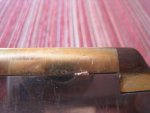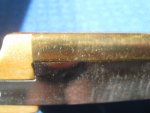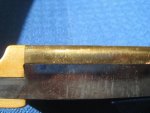Rob Keeble
Member
- Messages
- 12,633
- Location
- GTA Ontario Canada
Prior to me leaving SA my Dad told me to go to his workshop and take the tools I wanted to keep. He was already at the age and stage where he could no longer turn a screwdriver so for him it was to ensure the tools got handed down to me.
One of those tools i kept was what i come to know as a coffin smoother plane.
Now back in the day when my Dad and I used to work together, and he taught me what he knew, there was no such knowledge between the two of us as to the fact that a myriad of planes exist for all the different purposes. Even at high school shop class the teacher did not seem to know as all we had was a #4 type Stanley and they were in such bad shape that we never used them to plane never mind got taught that it was a smoother.
So when i got to Canada and set up to do woodworking as a hobby it was only after joining this forum and old grey beard taking an interest in me that i got to really learn about the range of planes and what they were all for.
As most of us do i went through a phase of tuning up planes and one that i never got around to was the coffin plane due to the fact that i really did not "get it"
The i found out that it is intended as a smoother, well i discovered that the throat of the plane had been messed with by my Dad. Obviously if one "thinks" that a plane is intended to take a good chunk of wood off in one swipe like a jack plane then when one in ignorance comes across a coffin smoother that should for smoothing purposes have a narrow throat gap between blade edge and sole, one goes and files the throat bigger and this is what my Dad must have done to this plane.
Its got a good blade and the body is still like new so I plan to fix it.
The question is how.
One option i have come across in my research is putting a new sole on. I dont wish to do this.
What i have in mind that i would like comments on is to use a brass strip and fit it in front of the blade much the same as the old wooden spokeshaves have
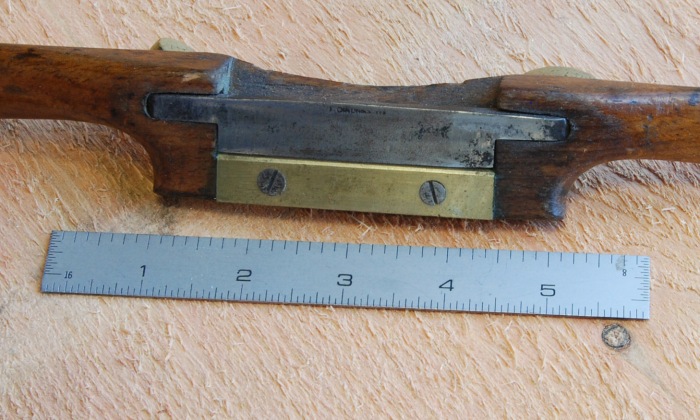
In doing some research on the web the only other person i can find is a image Derek Cohen of Australia posted on Lumberjocks of how he put a piece of brass patch in one of his wooden planes. I could not find the post to this on his website even after google searching the image. And Derek does not have search on his own website.
http://www.inthewoodshop.com/index.html
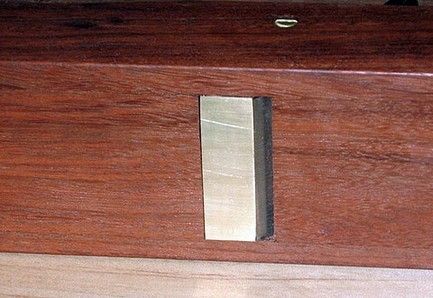
Anyone here have an idea how he secured this patch in the plane? The wood he uses much of the time is Jarrah (Eucalyptus ) and its hard and I don't see it taking to absorbing epoxy too well. But don't know.
I was originally thinking of using screws and first putting inserts in and using machine screws but i actually would prefer what Derek has done as it does not have any nooks and cranny's.
The other day I was in an electronics components store and lucky me they had just the perfect strip of flat brass for this job hence it coming up on list of items i want to attend to.
So if you guys are still into woodworking and hand tools please let the debate begin i need all the input i can get before i take to modifying this plane.
BTW it has a great thick heavy blade so I think its well worth the effort besides it being a heirloom.
One of those tools i kept was what i come to know as a coffin smoother plane.
Now back in the day when my Dad and I used to work together, and he taught me what he knew, there was no such knowledge between the two of us as to the fact that a myriad of planes exist for all the different purposes. Even at high school shop class the teacher did not seem to know as all we had was a #4 type Stanley and they were in such bad shape that we never used them to plane never mind got taught that it was a smoother.
So when i got to Canada and set up to do woodworking as a hobby it was only after joining this forum and old grey beard taking an interest in me that i got to really learn about the range of planes and what they were all for.
As most of us do i went through a phase of tuning up planes and one that i never got around to was the coffin plane due to the fact that i really did not "get it"
The i found out that it is intended as a smoother, well i discovered that the throat of the plane had been messed with by my Dad. Obviously if one "thinks" that a plane is intended to take a good chunk of wood off in one swipe like a jack plane then when one in ignorance comes across a coffin smoother that should for smoothing purposes have a narrow throat gap between blade edge and sole, one goes and files the throat bigger and this is what my Dad must have done to this plane.
Its got a good blade and the body is still like new so I plan to fix it.
The question is how.
One option i have come across in my research is putting a new sole on. I dont wish to do this.
What i have in mind that i would like comments on is to use a brass strip and fit it in front of the blade much the same as the old wooden spokeshaves have

In doing some research on the web the only other person i can find is a image Derek Cohen of Australia posted on Lumberjocks of how he put a piece of brass patch in one of his wooden planes. I could not find the post to this on his website even after google searching the image. And Derek does not have search on his own website.
http://www.inthewoodshop.com/index.html

Anyone here have an idea how he secured this patch in the plane? The wood he uses much of the time is Jarrah (Eucalyptus ) and its hard and I don't see it taking to absorbing epoxy too well. But don't know.
I was originally thinking of using screws and first putting inserts in and using machine screws but i actually would prefer what Derek has done as it does not have any nooks and cranny's.
The other day I was in an electronics components store and lucky me they had just the perfect strip of flat brass for this job hence it coming up on list of items i want to attend to.
So if you guys are still into woodworking and hand tools please let the debate begin i need all the input i can get before i take to modifying this plane.
BTW it has a great thick heavy blade so I think its well worth the effort besides it being a heirloom.


